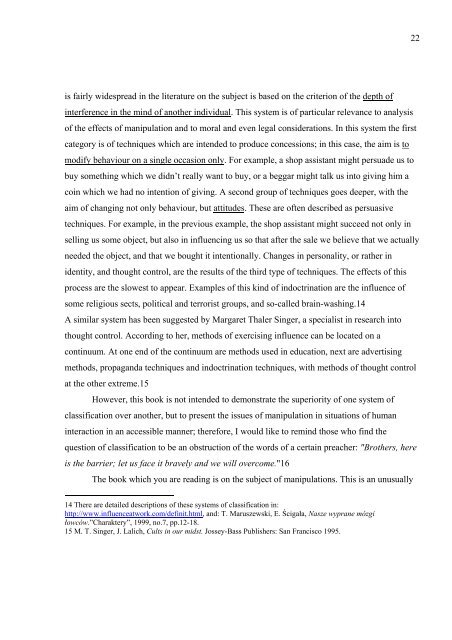PSYCHOMANIPULATION - Tomasz Witkowski
PSYCHOMANIPULATION - Tomasz Witkowski
PSYCHOMANIPULATION - Tomasz Witkowski
You also want an ePaper? Increase the reach of your titles
YUMPU automatically turns print PDFs into web optimized ePapers that Google loves.
is fairly widespread in the literature on the subject is based on the criterion of the depth of<br />
interference in the mind of another individual. This system is of particular relevance to analysis<br />
of the effects of manipulation and to moral and even legal considerations. In this system the first<br />
category is of techniques which are intended to produce concessions; in this case, the aim is to<br />
modify behaviour on a single occasion only. For example, a shop assistant might persuade us to<br />
buy something which we didn’t really want to buy, or a beggar might talk us into giving him a<br />
coin which we had no intention of giving. A second group of techniques goes deeper, with the<br />
aim of changing not only behaviour, but attitudes. These are often described as persuasive<br />
techniques. For example, in the previous example, the shop assistant might succeed not only in<br />
selling us some object, but also in influencing us so that after the sale we believe that we actually<br />
needed the object, and that we bought it intentionally. Changes in personality, or rather in<br />
identity, and thought control, are the results of the third type of techniques. The effects of this<br />
process are the slowest to appear. Examples of this kind of indoctrination are the influence of<br />
some religious sects, political and terrorist groups, and so-called brain-washing.14<br />
A similar system has been suggested by Margaret Thaler Singer, a specialist in research into<br />
thought control. According to her, methods of exercising influence can be located on a<br />
continuum. At one end of the continuum are methods used in education, next are advertising<br />
methods, propaganda techniques and indoctrination techniques, with methods of thought control<br />
at the other extreme.15<br />
However, this book is not intended to demonstrate the superiority of one system of<br />
classification over another, but to present the issues of manipulation in situations of human<br />
interaction in an accessible manner; therefore, I would like to remind those who find the<br />
question of classification to be an obstruction of the words of a certain preacher: "Brothers, here<br />
is the barrier; let us face it bravely and we will overcome."16<br />
The book which you are reading is on the subject of manipulations. This is an unusually<br />
14 There are detailed descriptions of these systems of classification in:<br />
http://www.influenceatwork.com/definit.html, and: T. Maruszewski, E. Ścigała, Nasze wyprane mózgi<br />
łowców.”Charaktery”, 1999, no.7, pp.12-18.<br />
15 M. T. Singer, J. Lalich, Cults in our midst. Jossey-Bass Publishers: San Francisco 1995.<br />
22


